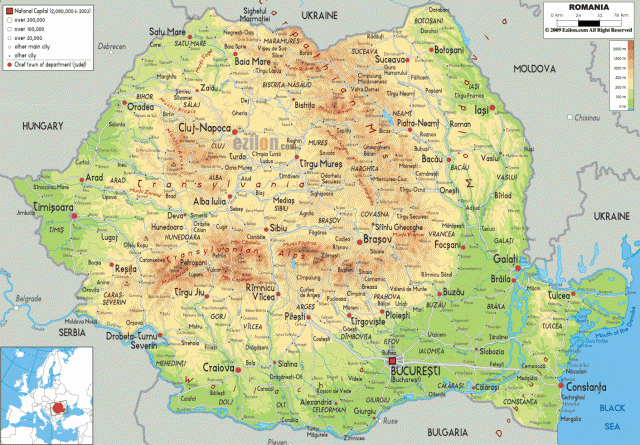Romania
Area 91,000 square mi (237,500 square km)
Population 19.91 million 2014
Capital Bucharest
Highest Point 8,346 ft (2,544 m)
Lowest Point 0 m
GDP $199.0 billion 2014
Primary Natural Resources oil, natural gas, timber, coal, iron ore.
ROMANIA IS AN OVAL-shaped country in southeastern Europe. Situated in the northeastern part of the Balkan Peninsula, it is halfway between the ATLANTIC OCEAN and the URAL MOUNTAINS and also halfway between the North Pole and the equator. It is slightly smaller than OREGON or about half the size of FRANCE.
The eastern border of Romania is the BLACK SEA. Moving in a counterclockwise direction, Romania is bordered by UKRAINE and MOLDOVa in the northeast, Ukraine in the north, HUNGARY in the west, SERBIA AND MONTENEGRO in the southwest, and BULGARIA in the south. The DANUBE river flows for nearly 900 mi (1,400 km) mostly through featureless plains on the southern and eastern border with Serbia, Bulgaria, Moldova, and Ukraine. Romania has six land regions: Dobruja, Moldavia, Bukovinia, Transylvania, Walachia, and Banat.

Dobruja is the driest region of Romania. Its largest city is Constansa, located on the Black Sea. Dobruja is formed by the change in direction from east to north by the Danube River, which bends east again at its confluence with the Siretul and Prut rivers. The northern third of Dobruja is the Danube's DELTA, which borders the Ukraine. The delta is one of Europe's great marsh regions. It is now a protected BIOSPHERE.
North of Dobruja is the Moldavia region. It lies between the eastern Carpathians and the Prut River, which borders the country of Moldova (Bessarabia). It is a plain with small hills and farmlands centered on both sides of the Siretul River and its tributaries.
Bukovinia is in the highest part of the Carpathian Mountains. It is thickly forested and dotted with small villages and ski resorts. Transylvania is the largest and most varied region in Romania. It lies in the central and northwestern part of the country. The Transylvanian Plateau is a basin bordered on the east by the eastern (Moldovian) Carpathians; on the west, by the Bihor Mountains; and by the Southern Carpathians (Transylvanian Alps) on the south.
Banat lies in southwestern Romania. Bordering Hungary in the northwest, Serbia in the west and Bulgaria in the southwest, it is the region with the greatest concentration of ethnic minorities—Hungarians, Germans, and Serbs. Its major city is Timisoara. Walachia is in the south. It rises in elevation northward from its Danube River border with Bulgaria to the Transylvanian Alps. The Olt River divides Walachia into Oltenia on the west and Muntenia on the east. The Danube forms a natural boundary between Walachia and Dobruja. Bucharest is located in the center of the Muntenia on the Buflea River.
Romania's Transylvanian Alps region is famous for its stories of vampires. The Dracula castle depicted in Bram Stoker's novel Dracula is located at Brasov. The historical Count Dracula was Vlad Tepes (“the Impaler”), whose castle was at Targoviste.